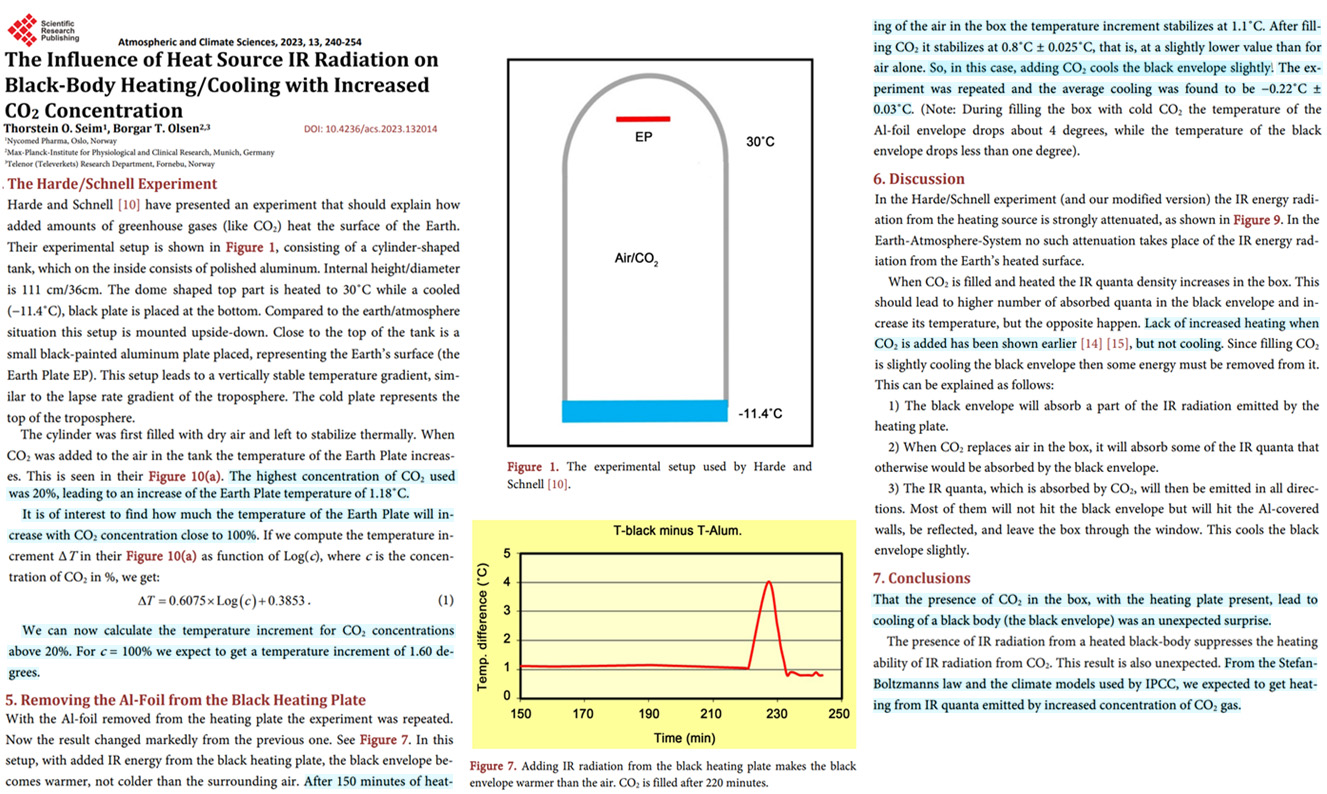“In a modified experiment, where IR emission from the heating source is present, no heating but a slight cooling of a black object is found when air is replaced by CO2. The modified experimental situation is also more like the earth/atmosphere situation.” – Seim and Olsen, 2023
Scientists Hermann Harde and Michael Schnell published a paper in 2021 entitled “Verification of the Greenhouse Effect in the Laboratory.” The study purported to experimentally determine that the atmospheric CO2 greenhouse effect not only exists, but functions in concert with physical laws.
“To our knowledge we present the first demonstration of the atmospheric greenhouse effect in a laboratory experiment, which also allows quantitative measurements under conditions as in the lower troposphere. We use an experimental set-up consisting of two plates in a closed housing, one plate in the upper position heated to 30°C, the other at the bottom and cooled to -11.4°C.”
Thorstein Seim and Borgar Olsen (2023) have analyzed their experimental setup in further detail. They discover that in the Harde and Schnell (2021) greenhouse effect experiment, when the CO2 is increased 500-fold, or from 0.04% (400 ppm) to 20% (200,000 ppm), the plate temperature increases by just 1.18°C. Further, raising CO2 from 20% to 100% (1,000,000 ppm) adds just 0.4°C additional warming (1.6°C).
Since it is assumed that the 100 ppm (0.01%) atmospheric CO2 increase since 1950, from ~310 to 410 ppm, has been the primary cause of 1950-to-present global warming, an experiment that shows increasing CO2 2500-fold (0.04% to 100%) only produces a warming of 1.6°C would hardly appear to support the “verification” of the CO2 greenhouse effect.

Image Source: Seim and Olsen, 2023
But it may be worse than that. Seim and Olsen modify the Harde and Schnell experiment to better simulate “the earth/atmosphere situation.” Instead of modestly increasing the plate temperature by a degree and a half, the modified experiment shows that increasing CO2 from 0.04% to 100% actually cools the blackbody (plate) by about -0.2 to -0.3°C.
The temperature stabilizes at 1.1°C after 150 minutes of heating when only air (78% N2, 21% O2, 0.04% CO2) is used in the container. But when the air is replaced by CO2 (100%), the temperature stabilizes at 0.8°C − a few tenths of a degree cooler. The average cooling when 0.04% CO2 is replaced with 100% CO2 is determined to be -0.22°C.
An observation that shows increasing CO2 by a factor of 2500 elicits cooling in a laboratory is characterized as an “unexpected surprise” by the authors.
Either way, experimental results that show only modest temperature changes occur when CO2 is dramatically increased do not lend support to the “verification” of the CO2 greenhouse effect. And it especially does not validate the popular viewpoint that CO2 is a driving factor in modern global warming.





the heating source should be visible light? which should be able to transit to the surface. the CO2 is suppose to impede heat transfer outbound
[…] – Lab Experiment Shows A 2500-Fold CO2 Increase Delivers Surface Cooling, Not Warming […]